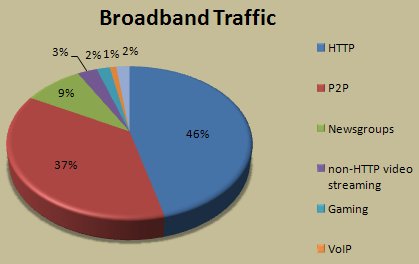
One of the reasons for the big surge in HTTP traffic is the rapid rise of Internet video sharing sites like YouTube, Google Video and others. Ellacoya claims YouTube has grown so big that it accounts for 20 percent of all HTTP traffic!

Newsgroups only account for 9% of the broadband traffic and non-HTTP video streaming for 3%. Gaming eats up another 2% and VoIP uses only 1%.
Looking over all the numbers, one of the most surprising result is the continued success of NNTP (newsgroups) traffic, which still accounts for nine percent of the total. Clearly, newsgroup discussions (and, ahem, binaries) are still big business.Source: ARS Technica.
The data may provide some ammunition for companies that favor traffic shaping on their networks. Between P2P, newsgroups, and streaming HTTP video traffic, the vast majority of Internet traffic is non-critical (i.e., no one's going to die or lose $20 million if they don't download a YouTube clip or a new song in under a minute). Networks that want to ensure priority transmission of VoIP calls, traditional HTTP web browsing, medical imaging, etc., have a strong incentive to throttle back that flood of non-critical traffic when the network is experiencing heavy loads. That could bring them into conflict with proponents of strict network neutrality, though, who don't want to see any sort of packet prioritization.